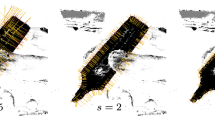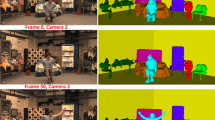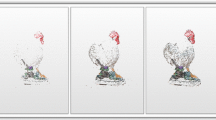Abstract
In this paper, we present a stochastic algorithm by effective Markov chain Monte Carlo (MCMC) for segmenting and reconstructing 3D scenes. The objective is to segment a range image and its associated reflectance map into a number of surfaces which fit to various 3D surface models and have homogeneous reflectance (material) properties. In comparison to previous work on range image segmentation, the paper makes the following contributions. Firstly, it is aimed at generic natural scenes, indoor and outdoor, which are often much complexer than most of the existing experiments in the “polyhedra world”. Natural scenes require the algorithm to automatically deal with multiple types (families) of surface models which compete to explain the data. Secondly, it integrates the range image with the reflectance map. The latter provides material properties and is especially useful for surface of high specularity, such as glass, metal, ceramics. Thirdly, the algorithm is designed by reversible jump and diffusion Markov chain dynamics and thus achieves globally optimal solutions under the Bayesian statistical framework. Thus it realizes the cue integration and multiple model switching. Fourthly, it adopts two techniques to improve the speed of the Markov chain search: One is a coarse-to-fine strategy and the other are data driven techniques such as edge detection and clustering. The data driven methods provide important information for narrowing the search spaces in a probabilistic fashion. We apply the algorithm to two data sets and the experiments demonstrate robust and satisfactory results on both. Based on the segmentation results, we extend the reconstruction of surfaces behind occlusions to fill in the occluded parts.
Chapter PDF
Similar content being viewed by others
Keywords
These keywords were added by machine and not by the authors. This process is experimental and the keywords may be updated as the learning algorithm improves.
References
P.J. Besl and R.C. Jain, “Segmentation through variable order surface fitting”, IEEE Trans. on PAMI, vol. 10, no. 2, pp167–192, 1988.
M. J. Black and A. Rangarajan, ”On the unification of line process, outlier rejection, and robust statistics with applications in early vision”, Int’l J. of Comp. Vis., Vol. 19, No. 1 pp 57–91. 1996.
F. Dell’Acqua and R. Fisher, ”Reconstruction of planar surfaces behind occlusions in range images”, To appear in IEEE Trans. on PAMI 2001.
P. J. Flynn and A.K. Jain, “Surface classification: hypothesis testing and parameter estimation”, Proc. of CVPR, 1988.
A. Gupta, A. Leonardis, and R. Bajcsy, “Segmentation of range images as the search for geometric parametric models”, Int’l J. of Computer Vision, 14(3), pp 253–277, 1995.
R. L. Hoffman and A. K. Jain, “Segmentation and classification of range images”, IEEE Trans. on PAMI, vol. 9, no. 5, pp608–620, 1987.
A. Hoover, et al. “An experimental comparison of range image segmentation algorithms”, IEEE Trans. on PAMI, vol. 18, no. 7, pp673–689, 1996.
J.G. Huang, A. B. Lee, and D.B. Mumford, “Statistics of range images”, Proc. of CVPR, Hilton Head, South Carolina, 2000.
R. Krishnapuram and S. Gupta, “Morphological methods for detection and classification of edges in range images”, Mathematical Imaging ans Vision, vol. 2 pp351–375, 1992.
Y. G. Leclerc and M.A. Fischler, “An optimization-based approach to the interpretation of single line drawings as 3D wire frame”, Int’l J. of Comp. Vis., 9:2, 113–136, 1992.
D. Marshal, G. Lukacs and R. Martin, ”Robust segmentation of primitives from range data in the presentce of geometric degeneracy”, IEEE Trans. on PAMI, Vol. 23, No. 3 pp 304–314. 2001.
A. P. Pentland, “Perceptual organization and the representation of natural form”, Artificial Intelligence, 28, 293–331, 1986.
Z. W. Tu, S. C. Zhu and H. Y. Shum, “Image segmentation by data driven Markov chain Monte Carlo.” Proc. of ICCV, Vancouver, 2001.
M. Umasuthan and A.M. Wallace, ”Outlier removal and discontinuity preserving smoothing of range data”, IEE Proc.-Vis. Image Signal Process, Vol. 143, No. 3, 1996.
A. L. Yuille and J. J. Clark, ”Bayesian models, deformable templates and compititive priors”, in in em Spatial Vision in Humans and Robots, L. Harris and M. Jenkin (eds.), Cambridge Univ. Press, 1993.
Z.Y. Zhang, ”Parameter estimation techniques: A tutorial with application to conic fitting”, Technical Report of INRIA, 1995.
S. C. Zhu and A. L. Yuille. “Region competition: unifying snakes, region growing, and Bayes/MDL for multiband Image Segmentation”. IEEE Trans. PAMI. vol. 18, No. 9. pp 884–900. 1996.
Author information
Authors and Affiliations
Editor information
Editors and Affiliations
Rights and permissions
Copyright information
© 2002 Springer-Verlag Berlin Heidelberg
About this paper
Cite this paper
Han, F., Tu, Z., Zhu, SC. (2002). A Stochastic Algorithm for 3D Scene Segmentation and Reconstruction. In: Heyden, A., Sparr, G., Nielsen, M., Johansen, P. (eds) Computer Vision — ECCV 2002. ECCV 2002. Lecture Notes in Computer Science, vol 2352. Springer, Berlin, Heidelberg. https://doi.org/10.1007/3-540-47977-5_33
Download citation
DOI: https://doi.org/10.1007/3-540-47977-5_33
Published:
Publisher Name: Springer, Berlin, Heidelberg
Print ISBN: 978-3-540-43746-8
Online ISBN: 978-3-540-47977-2
eBook Packages: Springer Book Archive




